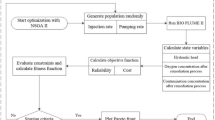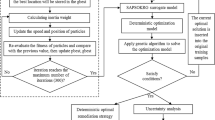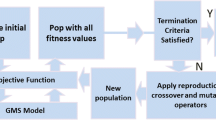Abstract
We examine the effect of uncertainty due to limited information on the remediation design of a contaminated aquifer using the pump and treat method. The hydraulic conductivity and contaminant concentration distributions for a fictitious contaminated aquifer are generated assuming a limited number of sampling locations. Stochastic optimization with multiple realizations is used to account for aquifer uncertainty. The optimization process involves a genetic algorithm (GA). As the number of realizations increases, a greater extraction rate and more wells are needed. There was a total cost increase, but the optimal remediation designs became more reliable. Stochastic optimization analysis also determines the locations for extraction wells, the variation in extraction rates as a function of the change of well locations, and the reliability of the optimal designs. The number of realizations (stack number) that caused the design factors to converge could be determined. Effective stochastic optimization may be achieved by reducing computational resources. An increase in the variability of the conductivity distribution requires more extraction wells. Information about potential extraction wells can be used to prevent failure of the remediation task.












Similar content being viewed by others
References
Aly AH, Peralta RC (1999) Optimal design of aquifer cleanup systems under uncertainty using a neural network and a genetic algorithm. Water Resour Res 35(8):2523–2532
Baú DA, Mayer AS (2006) Stochastic management of pump-and-treat strategies using surrogate functions. Adv Water Resour 29(12):1901–1917
Chan Hilton AB, Culver TB (2000) Constraint handling for genetic algorithms in optimal remediation design. J Water Resour Plann Manag 126(3):128–137
Christakos G, Killam BR (1993) Sampling design for classifying contaminant level using annealing search algorithms. Water Resour Res 29(12):4063–4076
Feyen L, Gorelick SM (2004) Reliable groundwater management in hydroecologically sensitive areas. Water Resour Res 40(7):7408. doi:10.1029/2003WR003003
Freeze RA, Gorelick SM (1999) Convergence of stochastic optimization and decision analysis in the engineering design of aquifer remediation. Ground Water 37(6):934–954
Goldberg DE (1989) Genetic algorithms in search, optimization, and machine learning. Addison-Wesley Inc., Reading, Massachusetts
Goovaerts P (1997) Geostatistics for natural resources evaluation. Oxford University Press, New York
Harbaugh AW, McDonald MG (1996) User’s documentation for MODFLOW-96, an update to the U.S. Geological survey modular finite-difference ground-water flow model. U.S. Geological survey open-file report 96–485, U.S. Geological Survey, Reston, Virginia
Huang C, Mayer AS (1997) Pump-and-treat optimization using well locations and pumping rates as decision variables. Water Resour Res 33(5):1001–1012
Johnson KJ, Minor CP, Guthrie VN, Rose-Pehrsson SL (2008) Intelligent data fusion for wide-area assessment of UXO contamination. Stoch Environ Res Risk Assess 23(2):237–252
Juang K.-W, Lee D.-Y, Ellsworth TR (2001) Using rank-order geostatistics for spatial interpolation of highly skewed data. J Environ Qual 30(3):894–903
Kelman J, Vieira AM, Rodriguez-Amaya JE (2000) El Niño influence on streamflow forecasting. Stoch Environ Res Risk Assess 14(2):123–138
Ko NY, Lee KK (2009) Convergence of deterministic and stochastic approaches in optimal remediation design of a contaminated aquifer. Stoch Environ Res Risk Assess 23(3):309–318
Ko NY, Lee KK, Hyun Y (2005) Optimal groundwater remediation design of a pump and treat system considering clean-up time. Geosci J 9(1):23–31
Maqsood I, Li J, Huang G, Huang Y (2005) Simulation-based risk assessment of contaminated sites under remediation scenarios, planning periods, and land-use patterns-a Canadian case study. Stoch Environ Res Risk Assess 19(2):146–157
Mayer AS, Kelley CT, Miller CT (2002) Optimal design for problems involving flow and transport phenomena in saturated subsurface system. Adv Water Resour 25(8–12):1233–1256
Metropolis N, Ulam S (1949) The Monte Carlo method. J Am Stat Assoc 44(247):335–341
Olea RA (1999) Geostatistics for engineers and earth scientists. Kluwer, Boston, MA
Pinder GF, Ricciardi K, Karatzas GP, Wobber F, Roesler G (2001) Least-cost groundwater remediation using uncertain hydrogeological information (final report). U.S. Department of Energy, Washington, DC
Reed PM, Ellsworth TR, Minsker BS (2004) Spatial interpolation methods for nonstationary plume data. Ground Water 42(2):190–202
Ren X, Minsker B (2005) Which groundwater remediation objective is better: a realistic one or simple one? J Water Resour Plann Manag 131(5):351–361
Sattari MT, Apaydin H, Ozturk F (2008) Operation analysis of Eleviyan irrigation reservoir dam by optimization and stochastic simulation. Stoch Environ Res Risk Assess. doi:10.1007/s00477-008-0292-9
Sawyer CS, Lin Y-F (1998) Mixed-integer chance-constrained models for ground-water remediation. J Water Resour Plann Manag 124(5):285–294
United States Environmental Protection Agency (USEPA) (1999) Groundwater cleanup: overview of operating experience at 28 sites. Office of Solid Waste and Emergency Response, Washington, DC
Wagner BJ (1995) Recent advances in simulation–optimization groundwater management modeling. Rev Geophys (US National Report to International Union of Geodesy and Geophysics) 1991–1994:1021–1028
Wagner BJ (1999) Evaluating data worth for ground-water management under uncertainty. J Water Resour Plann Manag 125(5):281–288
Wagner BJ, Gorelick SM (1989) Reliable aquifer remediation in the presence of spatially variable hydraulic conductivity: from data to design. Water Resour Res 25(10):2211–2225
Warner JW, Tamayo-Lara C, Khazaei E, Manghi F (2006) Stochastic management modeling of a pump and treat system at the Rocky Mountain Arsenal near Denver, Colorado. J Hydrol 328(3–4):523–537
Watkins DW Jr, McKinney DC (1997) Finding robust solutions to water resources problems. J Water Resour Plann Manag 123(1):49–58
Zheng C, Wang PP (1999) MT3DMS: a modular three-dimensional multispecies transport model for simulation of advection, dispersion, and chemical reactions of contaminants in groundwater systems: documentation and user’s guide, U.S. Army Engineer Research and Development Center Contract Report SERDP-99-1, Vicksburg, Mississippi
Acknowledgement
This study was supported by the Korea Ministry of Environment as “The GAIA Project” (#173-092-009) and AEBRC at POSTECH. The authors wish to thank the SERRA Associate Editor for his valuable comments and suggestions that improved the quality of the papers’ presentation.
Author information
Authors and Affiliations
Corresponding author
Rights and permissions
About this article
Cite this article
Ko, NY., Lee, KK. Information effect on remediation design of contaminated aquifers using the pump and treat method. Stoch Environ Res Risk Assess 24, 649–660 (2010). https://doi.org/10.1007/s00477-009-0352-9
Published:
Issue Date:
DOI: https://doi.org/10.1007/s00477-009-0352-9




